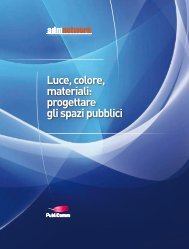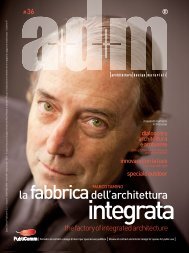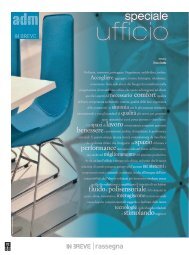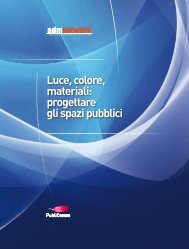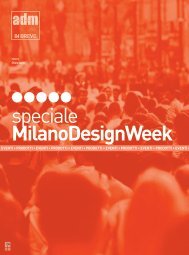Eco-innovazione dei materiali: la plastica - A+D+M Network
Eco-innovazione dei materiali: la plastica - A+D+M Network
Eco-innovazione dei materiali: la plastica - A+D+M Network
You also want an ePaper? Increase the reach of your titles
YUMPU automatically turns print PDFs into web optimized ePapers that Google loves.
# 44<br />
Casa Editrice Publicomm S.r.l. - Savona - ISSN 1826-0985 - Anno IX - Numero 44 - 2013 - In caso di mancato recapito rinviare all’Ufficio Postale di Savona CPO, per <strong>la</strong> restituzione tu<br />
al mittente tente che si impegnerà a pagare <strong>la</strong> re<strong>la</strong>tiva a tassa - Contiene IP<br />
Rigenerazione<br />
Radical regeneration<br />
in questo numero / in this issue<br />
Forme di scienza e natura<br />
Shapes of nature and science<br />
Valorizzare <strong>la</strong> luce<br />
Enhance the light<br />
NATURAL DESIGN THINKING<br />
METROGRAMMA<br />
radicale<br />
| Periodico di contract e design d’interni per spazi ad uso pubblico | Review of contract and interior design for spaces for public use |
ECO MATERIALI<br />
<strong>Eco</strong>-<strong>innovazione</strong><br />
<strong>dei</strong> <strong>materiali</strong>:<br />
LA PLASTICA<br />
Text by<br />
MATREC - <strong>Eco</strong>Materials Library<br />
<strong>Eco</strong>-innovation of materials: THE PLASTIC<br />
Le nuove soluzioni<br />
di p<strong>la</strong>stiche ricic<strong>la</strong>te<br />
completamente<br />
trasformate in sostituzione<br />
delle p<strong>la</strong>stiche<br />
vergini, oltre a portare<br />
benefici ambientali,<br />
permettono interessanti<br />
sperimentazioni in svariati<br />
settori.<br />
The new solutions of completely<br />
transformed recycled p<strong>la</strong>stics<br />
instead of virgin p<strong>la</strong>stics,<br />
in addition to bringing<br />
environmental benefits, allow<br />
interesting experimentations in<br />
several sectors.<br />
La p<strong>la</strong>stica è una sostanza<br />
organica sintetica ottenuta<br />
prevalentemente dall'impiego del petrolio.<br />
Il primo materiale p<strong>la</strong>stico, <strong>la</strong> bakelite,<br />
fece <strong>la</strong> sua iniziale comparsa nel 1907.<br />
Da questa data in avanti, il progresso<br />
tecnologico e le attività di ricerca<br />
aziendali hanno contribuito allo sviluppo<br />
di numerosissime tipologie di materie<br />
p<strong>la</strong>stiche, permettendo quindi a questa<br />
sostanza sintetica di imporsi nel<strong>la</strong> nostra<br />
vita quotidiana come il materiale più<br />
<strong>la</strong>rgamente impiegato per <strong>la</strong> realizzazione<br />
di svariati oggetti e prodotti di uso<br />
comune. Nonostante <strong>la</strong> sua rapida<br />
diffusione, ci si è resi ben presto conto<br />
che lo smaltimento <strong>dei</strong> prodotti in p<strong>la</strong>stica<br />
giunti a fine vita poteva rappresentare un<br />
problema di non facile soluzione.<br />
Nel 1991 con <strong>la</strong> mostra “Neolite:<br />
metamorfosi delle p<strong>la</strong>stiche”, tenutasi al<br />
Pa<strong>la</strong>zzo dell'Arte di Mi<strong>la</strong>no, Ezio Manzini<br />
e Antonio Petrillo affrontano il tema delle<br />
p<strong>la</strong>stiche e delle possibili trasformazioni<br />
durante il processo di riciclo. Sempre nei<br />
primi anni '90 è Anna Castelli Ferrieri<br />
a cimentarsi in sperimentazioni di <strong>Eco</strong>design,<br />
attraverso <strong>la</strong> creazione di sedute<br />
in p<strong>la</strong>stica ricic<strong>la</strong>ta.<br />
Con <strong>la</strong> spinta delle associazioni<br />
ambientaliste ad affrontare le diverse<br />
problematiche ambientali e con<br />
l’introduzione delle prime norme<br />
comunitarie in materia di riciclo <strong>dei</strong><br />
prodotti, anche <strong>la</strong> tecnologia inizia a<br />
proporre nuove soluzioni di p<strong>la</strong>stiche<br />
ricic<strong>la</strong>te completamente trasformate. Il<br />
costante e crescente rialzo del prezzo<br />
delle materie prime e l’avvio <strong>dei</strong> primi<br />
sistemi di raccolta, recupero e riciclo<br />
84<br />
<strong>A+D+M</strong> | MAGAZINE | 2013| # 44
delle p<strong>la</strong>stiche, spingono le aziende a<br />
prendere in considerazione l’utilizzo di<br />
p<strong>la</strong>stiche ricic<strong>la</strong>te in sostituzione delle<br />
p<strong>la</strong>stiche vergini, inizialmente per tutta<br />
una serie di prodotti per i quali non sono<br />
richieste elevate performance tecniche<br />
ed estetiche.<br />
Riciclo e benefici ambientali<br />
Le p<strong>la</strong>stiche che si possono avviare al<br />
riciclo sono prevalentemente quelle<br />
appartenenti al<strong>la</strong> categoria delle<br />
termop<strong>la</strong>stiche le quali hanno un<br />
diverso comportamento in fase di riciclo,<br />
presentando caratteristiche prestazionali<br />
differenti, in alcuni casi estremamente<br />
valide anche dopo uno o più processi<br />
di riciclo. Il PET ricic<strong>la</strong>to, ad esempio,<br />
mantiene quasi inalterate le proprietà del<br />
polimero vergine e può essere sottoposto<br />
a numerose <strong>la</strong>vorazioni. Questo è il<br />
motivo per cui è una delle tipologie di<br />
p<strong>la</strong>stica ricic<strong>la</strong>ta più <strong>la</strong>rgamente diffusa<br />
ed utilizzata. Viene infatti impiegata per <strong>la</strong><br />
realizzazione di contenitori e oggettistica<br />
e, sotto forma di fibra, per <strong>la</strong> produzione<br />
di indumenti, capi di abbigliamento e<br />
pannelli iso<strong>la</strong>nti.<br />
Ad ogni modo, il successo del processo<br />
di riciclo, e <strong>la</strong> conseguente qualità <strong>dei</strong><br />
← Materiale ricic<strong>la</strong>bile composito ottenuto<br />
parzialmente da fonte rinnovabile, costituito da<br />
polietilene e legno ricic<strong>la</strong>ti post-consumo. Indicato per<br />
applicazioni che richiedono buone tenute meccaniche<br />
a rottura, unite a peculiari caratteristiche di e<strong>la</strong>sticità.<br />
Utilizzato per pavimentazioni per interni ed esterni e per<br />
pareti venti<strong>la</strong>te di edifici.<br />
Materiale ricic<strong>la</strong>to post-consumo: 70% legno, 30% PE<br />
Il materiale ha ottenuto una certificazione ambientale<br />
di prodotto<br />
Consumi energetici: 9,11 kWh/kg<br />
Emissioni climalteranti: 0,33 kg CO2 eq/kg<br />
MATREC code: RWOOPLA0574<br />
www.matrec.com<br />
↑↗→Materiale ricic<strong>la</strong>bile composito realizzato<br />
parzialmente da fonte rinnovabie con oltre il 50% di<br />
carta e poliestere ricic<strong>la</strong>ti, <strong>la</strong> cui componente di p<strong>la</strong>stica<br />
ricic<strong>la</strong>ta proviene da processi di produzione e <strong>la</strong>vorazione<br />
delle etichette autoadesive. Utilizzato per <strong>la</strong> realizzazione<br />
di pavimentazioni e rivestimenti verticali in ambienti<br />
esterni.<br />
Materiale vergine: PP<br />
Materiale ricic<strong>la</strong>to: fibre di cellulosa, PP<br />
Consumi energetici: 9,30 kWh/kg<br />
Emissioni climalteranti: 1,04 kg CO2 eq/kg<br />
MATREC code: RPAPPLA0957<br />
www.matrec.com<br />
<strong>A+D+M</strong> | MAGAZINE | 2013 | # 44 85
prodotti ottenuti, dipende da come viene<br />
operata <strong>la</strong> fase di selezione del materiale<br />
raccolto. Prima di essere avviate al<br />
riciclo, infatti, le p<strong>la</strong>stiche devono essere<br />
separate dalle sostanze contaminanti e<br />
poi divise per famiglie di appartenenza.<br />
Solo al termine del<strong>la</strong> fase di selezione, <strong>la</strong><br />
p<strong>la</strong>stica rimanente può essere ricic<strong>la</strong>ta<br />
ottenendo così scaglie o granuli, pronti per<br />
essere reimpiegati in nuovi cicli produttivi<br />
per ottenere nuovi prodotti ed applicazioni.<br />
Diversi sono i benefici ambientali derivanti<br />
dall’utilizzo di un materiale p<strong>la</strong>stico<br />
↑ Materiale ricic<strong>la</strong>bile solido a base di<br />
poliestere con contenuto di ricic<strong>la</strong>to preconsumo<br />
pari al 30%. Impiegato per <strong>la</strong><br />
realizzazione di vari tipi di superfici e nell'arredamento<br />
di ambienti domestici, pubblici e<br />
commerciali.<br />
Materiale ricic<strong>la</strong>to pre-consumo:<br />
30% poliestere<br />
Consumi energetici: 8,54 kWh/kg<br />
Emissioni climalteranti: 6,03 kg CO2 eq/kg<br />
MATREC code: RPLA0608<br />
www.matrec.com<br />
↓ Materiale ricic<strong>la</strong>bile realizzato in fibre di PET<br />
ricic<strong>la</strong>to. Trova impiego come iso<strong>la</strong>nte acustico in<br />
ambienti commerciali dove è necessario un alto<br />
livello di assorbimento del rumore.<br />
Materiale vergine: 40% PET<br />
Materiale ricic<strong>la</strong>to: 60% fibre di PET<br />
Consumi energetici: 12,86 kWh/kg<br />
Emissioni climalteranti: 1,76 kg CO2 eq/kg<br />
MATREC code: RPLA0919<br />
www.matrec.com<br />
ricic<strong>la</strong>to in sostituzione dello stesso<br />
materiale vergine: vengono diminuiti i<br />
volumi di materiale p<strong>la</strong>stico destinato<br />
al<strong>la</strong> discarica e salvaguardate le risorse<br />
naturali non rinnovabili (il petrolio).<br />
Inoltre nel<strong>la</strong> maggior parte <strong>dei</strong> casi, il<br />
solo processo di riciclo del<strong>la</strong> p<strong>la</strong>stica<br />
(inteso come fase di trasformazione<br />
dal rifiuto al granulo), comporta minori<br />
emissioni climalteranti e minori consumi<br />
di energia rispetto al<strong>la</strong> produzione del<strong>la</strong><br />
p<strong>la</strong>stica vergine. Facendo alcuni esempi<br />
in numeri, utilizzando un chilogrammo di<br />
PET ricic<strong>la</strong>to, in sostituzione del materiale<br />
vergine, si ottiene una riduzione delle<br />
emissioni climalteranti pari a circa 1,81<br />
kgCO2 eq e <strong>dei</strong> consumi energetici pari a<br />
circa 16,58 kWh, mentre un chilogrammo<br />
di PA (poliammide, tra cui il più comune<br />
è il nylon) ricic<strong>la</strong>to, in sostituzione dello<br />
stesso vergine, permette una riduzione<br />
delle emissioni climalteranti pari a circa<br />
6,83 kgCO2 eq e <strong>dei</strong> consumi energetici<br />
pari a circa 19,60 kWh.<br />
Applicazioni<br />
Le p<strong>la</strong>stiche ricic<strong>la</strong>te trovano <strong>la</strong>rgo<br />
impiego in molteplici comparti<br />
merceologici. Ad esempio nel settore<br />
edile, dove vengono impiegate non solo<br />
per <strong>la</strong> realizzazione di tubature, pannelli e<br />
<strong>materiali</strong> iso<strong>la</strong>nti, ma anche in prodotti che<br />
devono essere utilizzati a vista e che quindi<br />
86<br />
<strong>A+D+M</strong> | MAGAZINE | 2013| # 44
←↙Materiale ricic<strong>la</strong>bile realizzato al 100% in<br />
polietilene proveniente dal riciclo <strong>dei</strong> contenitori<br />
per alimenti, dall'aspetto simile al marmo con<br />
venature di diversi colori. I pannelli trovano<br />
impiego nelle più svariate applicazioni in ambienti<br />
pubblici, di <strong>la</strong>voro o domestici.<br />
Materiale ricic<strong>la</strong>to post-consumo: 100% HDPE<br />
Consumi energetici: 5,72 kWh/kg<br />
Emissioni climalteranti: 1,10 kg CO2 eq/kg<br />
MATREC code: RPLA0580<br />
www.matrec.com<br />
richiedono una buona valenza estetica,<br />
come le pavimentazioni, i rivestimenti<br />
e le superfici decorative. Inoltre, da<br />
qualche anno si cerca di utilizzare <strong>la</strong><br />
p<strong>la</strong>stica ricic<strong>la</strong>ta come componente per<br />
realizzare l’asfalto stradale. Ed è proprio<br />
<strong>la</strong> città di Vancouver che sta studiando<br />
<strong>la</strong> p<strong>la</strong>stica con questo scopo, nell’ambito<br />
degli standard di sostenibilità che ha<br />
fissato e che intende raggiungere entro il<br />
2020. Questo implica un minore impiego<br />
di carburante destinato al processo<br />
produttivo e una diversa destinazione<br />
<strong>dei</strong> rifiuti p<strong>la</strong>stici, non più indirizzati<br />
alle discariche. Per quanto riguarda<br />
l’arredo urbano, sedie, panchine, tavoli<br />
e recinzioni in p<strong>la</strong>stica ricic<strong>la</strong>ta sono<br />
oramai <strong>la</strong>rgamente diffusi ed utilizzati<br />
sia nelle aree pubbliche e commerciali,<br />
sia in ambito privato e domestico. In<br />
campo tessile, sono diversi i prodotti<br />
che si possono realizzare utilizzando<br />
fi<strong>la</strong>ti in p<strong>la</strong>stica ricic<strong>la</strong>ta, come il nylon<br />
e il poliestere: maglioni, sciarpe, coperte,<br />
guanti, cappelli, t-shirt,...<br />
Sono diverse le aziende internazionali<br />
del settore moda che hanno prodotto<br />
intere collezioni realizzate in<br />
p<strong>la</strong>stica ricic<strong>la</strong>ta, come ad esempio<br />
<strong>la</strong> linea “Conscious” dell'azienda di<br />
abbigliamento svedese H&M e i jeans<br />
“8 bottles = 1 jean” firmati Levi's ® .<br />
| www.admnetwork.it | follow us on |<br />
→ Materiale ricic<strong>la</strong>bile fonoassorbente realizzato in<br />
poliestere ricic<strong>la</strong>to e rivestito in tessuto, disponibile<br />
in piastrelle a forma di L. Ideale per essere montato<br />
come rivestimento a parete per l'iso<strong>la</strong>mento<br />
acustico.<br />
Materiale vergine: fibre tessili<br />
Materiale ricic<strong>la</strong>to: poliestere<br />
Il materiale ha ottenuto una certificazione ambientale<br />
di prodotto<br />
Consumi energetici: 9,74 kWh/kg<br />
Emissioni climalteranti: 1,18 kg CO2 eq/kg<br />
MATREC code: RPLA0422<br />
www.matrec.com<br />
<strong>A+D+M</strong> | MAGAZINE | 2013 | # 44 87
↑ Materiale ricic<strong>la</strong>bile ottenuto parzialmente da<br />
fonte rinnovabile, composto da polimeri termop<strong>la</strong>stici<br />
ricic<strong>la</strong>ti e scarti di produzione di <strong>la</strong>minato,<br />
costituito da fibre cellulosiche impregnate di resine<br />
termoindurenti. Disponibile in diverse colorazioni,<br />
può essere accoppiato con film p<strong>la</strong>stici o tessuti.<br />
Materiale ricic<strong>la</strong>to: PP<br />
Materiale ricic<strong>la</strong>to pre-consumo: fibre di cellulosa,<br />
resina termoindurente<br />
Il materiale ha ottenuto una certificazione<br />
ambientale di prodotto<br />
MATREC code: RPAPPLA0374<br />
www.matrec.com<br />
← Materiale ottenuto dal riciclo di PVC e di fibre di<br />
poliestere provenienti da coperture per piscine, membrane<br />
industriali <strong>dei</strong> tetti e scarti di tappezzeria delle automobili.<br />
Le fibre di poliestere vengono aggiunte per accrescere<br />
<strong>la</strong> rigidità generale del materiale e <strong>la</strong> forza fisica.<br />
Originariamente utilizzato come pavimentazione industriale,<br />
viene oggi applicato in molteplici settori, tra i quali<br />
l'arredamento e l'oggettistica.<br />
Materiale ricic<strong>la</strong>to: 90% PVC, 10% fibre di poliestere<br />
Altri <strong>materiali</strong> presenti: additivo fungicida Vinyzene ® ,<br />
pigmenti<br />
Consumi energetici: 6,09 kWh/kg<br />
Emissioni climalteranti: 1,10 kg CO2 eq/kg<br />
MATREC code: RPLA0556<br />
www.matrec.com<br />
The p<strong>la</strong>stic is a synthetic organic substance obtained<br />
mainly from the use of oil. The first p<strong>la</strong>stic material,<br />
the bakelite, appeared in 1907. From this date<br />
onwards, the technological progress and business<br />
research activities contributed to the development of<br />
several types of p<strong>la</strong>stics, thus allowing this synthetic<br />
substance to establish itself in our daily lives as the<br />
material most widely used for the construction<br />
of various objects and commonly used products.<br />
Despite its rapid spread, it was soon realized that<br />
the disposal of p<strong>la</strong>stic products at the end of their life<br />
could be a problem difficult to solve. In 1991 with the<br />
exhibition "Neolite: metamorphosis of p<strong>la</strong>stics" held<br />
at the Pa<strong>la</strong>zzo dell'Arte in Mi<strong>la</strong>n, Ezio Manzini and<br />
Antonio Petrillo addressed the issue of p<strong>la</strong>stics and<br />
the possible transformations during the recycling<br />
process. In the early '90s, Anna Castelli Ferrieri<br />
dealt with eco-design experimentations through<br />
the creation of chairs made of recycled p<strong>la</strong>stic.<br />
With the push of environmental associations to<br />
deal with several environmental issues and with<br />
the introduction of the first EU rules re<strong>la</strong>ting to the<br />
recycling of products, the technology has begun<br />
to offer new solutions of completely transformed<br />
recycled p<strong>la</strong>stics. The constant and growing rise<br />
in price of raw materials and the start of the first<br />
systems of collection, recovery and recycling of<br />
p<strong>la</strong>stics, have forced the companies to consider the<br />
use of recycled p<strong>la</strong>stics instead of virgin p<strong>la</strong>stics,<br />
initially for a whole series of products for which<br />
high technical and aesthetic performances are not<br />
required.<br />
Recycling and environmental benefits<br />
The p<strong>la</strong>stics that can be recycled are mainly those<br />
belonging to the c<strong>la</strong>ss of thermop<strong>la</strong>stics, which<br />
have a different behaviour in the recycling phase,<br />
presenting different performance characteristics,<br />
in some cases extremely valid even after one<br />
or more recycling processes. The recycled<br />
PET, for example, maintains almost unaltered<br />
the properties of the virgin polymer and can be<br />
subjected to several processing. This is the reason<br />
why it is one of the most widely spread and used<br />
types of recycled p<strong>la</strong>stic. As a matter of fact, it is<br />
used to create containers and objects and, as a<br />
fibre, for the production of garments, clothing and<br />
insu<strong>la</strong>ting panels.<br />
However, the success of the recycling process and<br />
the consequent quality of the products obtained<br />
depend on how the selection phase of the collected<br />
material is carried out. Before being sent to<br />
recycling, in fact, the p<strong>la</strong>stics must be separated<br />
from the contaminants and then divided by families<br />
of belonging. Only at the end of the selection phase,<br />
88<br />
<strong>A+D+M</strong> | MAGAZINE | 2013| # 44
the remaining p<strong>la</strong>stic can be recycled, thus<br />
obtaining f<strong>la</strong>kes or granules, ready to be reused<br />
in new production cycles to obtain new products<br />
and applications.<br />
There are several environmental benefits arising<br />
from the use of a recycled p<strong>la</strong>stic material instead<br />
of a virgin material: the volumes of p<strong>la</strong>stic material<br />
destined to the <strong>la</strong>ndfill are reduced and the nonrenewable<br />
natural resources (oil) are safeguarded.<br />
Furthermore, in most cases only the process of<br />
p<strong>la</strong>stic recycling (as a transformation phase from<br />
waste to granule) results in lower greenhouse<br />
gas emissions and lower energy consumption<br />
compared to the production of virgin p<strong>la</strong>stic. Let's<br />
consider some numerical examples. By using a<br />
kilogram of recycled PET, instead of the virgin<br />
material, there is a reduction of greenhouse gas<br />
emissions equal to about 1.81 kgCO2 and of energy<br />
consumption of approximately 16.58 kWh, while a<br />
kilogram of recycled PA (polyamide, among the<br />
nylon is the most common), instead of the virgin<br />
material, allows a reduction of greenhouse gas<br />
emissions equal to about 6.83 kgCO2 and of energy<br />
consumption of approximately 19.60 kWh.<br />
Applications<br />
The recycled p<strong>la</strong>stics are widely used in many<br />
commodity sectors. For example in the construction<br />
industry, they are used not only for the production of<br />
pipes, panels and insu<strong>la</strong>ting materials, but also<br />
in products that must be exposed and therefore<br />
require a good aesthetic value, such as floorings,<br />
coatings and decorative surfaces.<br />
In addition, since a few years, the recycled p<strong>la</strong>stics<br />
are also used as a component to obtain road<br />
asphalt. The city of Vancouver is studying the p<strong>la</strong>stic<br />
material for this purpose, within the sustainability<br />
standards set that it wants to achieve by 2020.<br />
This implies a reduction in the use of fuel for the<br />
production process and a different destination of<br />
the p<strong>la</strong>stic waste, no longer directed to the <strong>la</strong>ndfills.<br />
With regards to the urban furniture, chairs,<br />
benches, tables and fences made of recycled p<strong>la</strong>stic<br />
are now widely spread and used both in public and<br />
commercial areas and for private and domestic<br />
use. In the textile field, there are several products<br />
that can be made by using recycled p<strong>la</strong>stic yarns,<br />
such as nylon and polyester: sweaters, scarves,<br />
b<strong>la</strong>nkets, gloves, hats, T-shirts, ...<br />
There are several international companies<br />
in the fashion industry which have produced<br />
entire collections made from recycled p<strong>la</strong>stic,<br />
such as the "Conscious" line by the Swedish<br />
clothing company H&M and the jeans "8<br />
bottles = 1 jean" signed by Levi's ® .<br />
↑→Materiale ricic<strong>la</strong>bile realizzato dal 75<br />
al 100% in ABS ricic<strong>la</strong>to pre e post-consumo,<br />
proveniente dai flussi di rifiuti dell'industria<br />
automobilistica, elettronica e dagli elettrodomestici.<br />
Trova impiego nel<strong>la</strong> realizzazione di prodotti e semi<strong>la</strong>vorati<br />
per l'arredamento.<br />
Materiale vergine: 0-25% ABS<br />
Materiale ricic<strong>la</strong>to: 75-100% ABS<br />
Il materiale ha ottenuto una certificazione<br />
ambientale di prodotto<br />
Consumi energetici: 10,63 kWh/kg<br />
Emissioni climalteranti: 1,71 kg CO2 eq/kg<br />
MATREC code: RPLA0951<br />
www.matrec.com<br />
<strong>A+D+M</strong> | MAGAZINE | 2013 | # 44 89



